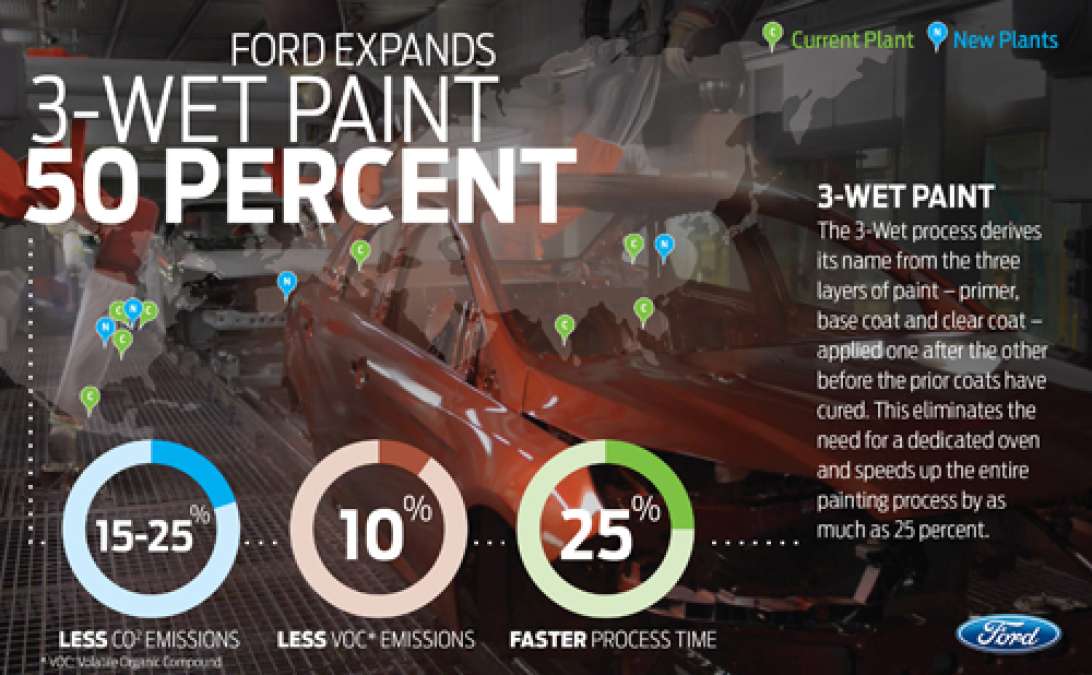Though many automakers are looking at this aspect of the industry, as it is a place where applying new methods can quickly improve their environmental standing, the old ways involved the release of phosphates, carbon dioxide, nickel, copper and hexavalent chromium into the atmosphere.
In addition, because of high temperature drying ovens, paint shops often accounted for up to 50 percent of an assembly plant’s energy use and up to 20 percent of the total energy required in the entire automotive fabrication process.
Ford is adding its 3-Wet painting process to four more plants, in addition to eight other plants that have been using this system since 2007. The four new manufacturing sites include two in the US and one each in China and Spain.
Ford plants in Michigan, Ohio, Kentucky and Cuautitlán, Mexico have been using this process for years, along with others in India, China, Thailand and Romania.
The 3-Wet process will be added to the capabilities of Flat Rock MI, Kansas City MO, Jiangxi/Nanchang, China and Valencia, Spain.
“The 3-Wet paint process is significantly more advanced than conventional technologies in applying durable paints in a high-quality, environmentally sound and cost-efficient manner,” said Bruce Hettle, director of manufacturing engineering.
The process is named for the fact it consists of three layers of paint applied one after the other without curing or, in other terms, while still wet, eliminating the energy and time consumed by and in drying ovens. Primer, base, color and sealer are all applied in quick succession, formulated to cure and dry without betraying the purpose or function of any layer. Thanks to advanced chemical composition each layer can be applied while the previous coating is still wet.
This technology allows Ford to continue to provide the top quality finish its customers expect, without sacrificing durability or chip and scratch resistance.
Ford estimates this process reduces CO2 emissions by 15 to 25 percent, release of volatile organic compounds by 10 percent and speeds up production time by as much as 25 percent.
The advanced chemistry involved uses a solvent-borne paint with a high solids content, formulated by Ford and its suppliers to adapt the product to the process. The collaboration produced not only a savings of 20-25 percent of the time required, but also served to eliminate stand-alone primer application and drying ovens.
A bonus comes in the form of a reduced footprint for the paint shop. That saves the brand power costs on the blowers that circulate massive amounts of air through the booths, and cuts the use of natural gas to heat the air and ovens. Consequently, CO2 emissions are reduced along with reductions in VOC releases, compared to medium-solids and solvent-borne paints.
While Torque News tends, at times, to celebrate speed and power, we are also fully in favor of anything that furthers environmental sustainability for the children of our children’s children.
Congratulations to Ford – here’s hoping it doesn’t take six more years to get this process into the rest of their manufacturing plants. They plan to complete the task by 2017, but we think three years should be enough.
We’re also impressed with the level of recycled and plant based content in Ford vehicles, as it demonstrates a true commitment to the world we live in.
How ‘bout you?





